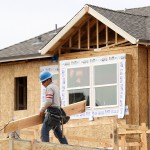Boise’s Housing Bust Leaves Unlikely Victims In A Neighborhood That Saw The Worst
Homeowners, credit intact, still making their monthly mortgage payments. They’re not who we think of first when we think of the damage brought on by the housing crisis. But in a sprawling, master-planned southwest Boise subdivision called Charter Pointe, they’re a group that has struggled.
More than most cities, Boise felt the brunt of the housing crisis. Home prices dropped by 46 percent. Foreclosures peaked in the Boise area three years ago, in March of 2010. County records show that a year after that, 90 percent of the houses that sold in Charter Pointe were foreclosures or short sales. We wondered: What is the story now in a place that bore the weight of collapsing home prices?
These days, if you pay Charter Pointe a visit, you’ll drive through a maze of tidy streets and cul-de-sacs, lined by traditional, four-square homes. They’re built close together. Most are two stories with garages and small yards, front and back. In addition, you’ll spot “for rent” signs. Here and there are houses that don’t appear occupied. It’s a suspicion neighbors confirm.
Of the hundreds of homes in Charter Pointe, one belongs to Scott and Tara Arellano. They explain that their three children, ages four to 15, are a big part of the reason they decided to move to this development in the first place.
“We really had this vision of getting in at the grass roots level,” Scott Arellano says.
They hoped to live on a street with other young families. They were attracted by amenities like public walking paths and parks. There would even be a clubhouse and pool.
This was in early 2005. The Arellanos had a home in Boise, but it was starting to feel small. They were thinking of adding on when they realized they could afford a larger, brand new house in Charter Pointe. Tara remembers their first visit. Much of what would become houses, sidewalks and residential streets still looked like open agricultural land. Construction was in its early stages.

Molly Messick / StateImpact Idaho
A "for rent" sign stood in front of a home in Charter Pointe last week.
“We drove out here, and they had a map of the planned community, and so we were able to see what the vision was,” she remembers. “They had a brand new school being built.”
For $188,000, they could buy the smallest house on a street of big homes. They could afford that. They signed a 30-year fixed-rate mortgage, and moved in by the end of the year.
It’s important to understand the hope the Arellanos felt about their new neighborhood to understand how dramatically their feelings have shifted since then. Now, Scott Arellano says, the decision to move to this neighborhood eats at him.
“As I come home from work, every single day, I think about it,” he says. “I think about what a disappointment it’s become.”
Not long after the Arellanos settled in, they noticed something. The neighborhood that they say was pitched to them as a family-oriented place where most houses would be owner-occupied wasn’t turning out to be that way. There were a lot of renters, which meant a lot of turnover.
“I have given up trying to keep track of who’s who,” Scott says. “It’s sad, because you don’t want to live in a neighborhood like that. You want to know your neighbors.”
There’s no doubt that investor-buyers became a big part of business in Charter Pointe. In 2005, more than a third of the development’s nearly 340 homes were investor-owned.
Shaun Tracy, a ReMax real estate agent in Boise, played a role in that rush to buy. He’s sold dozens of homes in Charter Pointe, some to homeowners, and many to investors. He first heard about the development in late 2004, a few months before the Arellanos did. He took a prospective home-buyer out for a visit. He remembers that the prices blew them away – in a good way.
“A small but functional three-bedroom two-bath home with a two-car garage had a base price of just under $90,000,” he says. “In 2004, that was sort of unheard of. We didn’t have that in Ada County.”
The developer, Hubble Homes, planned to build hundreds and hundreds of houses in Charter Pointe. That minimized costs, in keeping with Hubble’s slogan: More Space, Less Money. Tracy’s client signed a contract on the spot. Eventually, Tracy bought eight homes in the neighborhood.
“I knew how much I could rent these homes for, so I started telling investors about it,” he says.
The tipping point came not long after he sold two houses to a buyer in San Diego. “Suddenly, I started getting calls from people,” he remembers. “People from Florida were calling. Arizona. And they’d never even been to Boise, ever. In their life.”
They wanted houses in Charter Pointe.
Tracy says none of the investors he worked with lost their homes to foreclosure after prices tanked. Like him, they sold before the crash, or they still own property in the development. But it’s clear that some investors did go belly-up, and a lot homeowners did, too. And then there are people like the Arellanos.
“We came in thinking conventionally,” Scott Arellano explains. “Like, ‘We’re going to actually live in our property.’ But I think so many people were thinking in terms of paper value.”
Looking back, Arellano thinks he was naïve. He had a picture in his head of what life in Charter Pointe would be like. Now, he and his wife, Tara, are tied to an underwater mortgage.
They could walk away, but the idea of a strategic foreclosure doesn’t sit right. Neither does renting out their home, as others have done. Prices are coming back, Arellano observes. For now, their plan is to wait.


